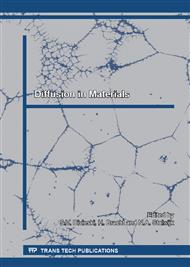p.62
p.68
p.79
p.85
p.91
p.101
p.106
p.112
p.120
Kinetics of Void Growth in Cubic Metals: Theory and Simulation
Abstract:
We examine the effect of elastic stresses induced by growing voids on the diffusion vacancy fluxes using newly derived equations. One of the main goals of our work is to obtain a kinetic equation for the growth rate of voids in cubic metals. The diffusion equation for vacancies, in which the influence of elastic stress near the void on the flux is taken into account, is linearized and solved. Then after mathematical transformations that are similar to Lifshitz - Slyozov theory, kinetic equations for the growth rate of the voids in fcc and bcc metals are obtained. The kinetic equations contain additional terms due to developed strain. This feature distinguishes the present equation from known ones and changes the kinetic of void growth. The functional dependence on strain is determined by coefficients, which characterize the strain influence on diffusion (SID coefficients). These coefficients are very sensitive to the atomic structure in the nearest vicinity of the saddle-point configuration. We have built an advanced model to evaluate them. SID coefficient simulation is the next step of this work. Using the kinetic equations and the SID coefficients, we calculate the void growth rate in cubic metals under different conditions.
Info:
Periodical:
Pages:
91-98
Citation:
Online since:
May 2015
Authors:
Keywords:
Price:
Сopyright:
© 2015 Trans Tech Publications Ltd. All Rights Reserved
Share:
Citation:


